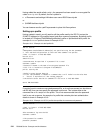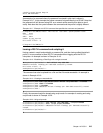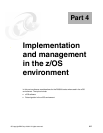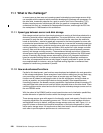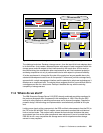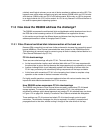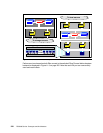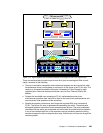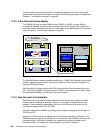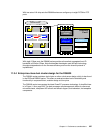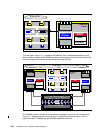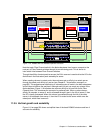222 DS6000 Series: Concepts and Architecture
11.2.1 SSA backend interconnection
The Storage Serial Architecture (SSA) connectivity with the SSA loops in the lower level of
the storage server or backend imposed RAID rank saturation and reached their limit of 40
MB/sec for a single stream file I/O. IBM decided not to pursue SSA connectivity, despite its
ability to communicate and transfer data within an SSA loop without arbitration.
11.2.2 Arrays across loops
Advancing from the F20 to the 800 model, the internal structures and buses increased two
fold and so did the backend with striping logical volumes across loops (AAL). This increased
the sequential throughput on an SSA loop from 40 MB/sec to 80 MB/sec for a single file
operation, distributing the backend I/O across two loops. Because of the increasing
requirements to serve more data and at the same time reduce the application I/O response
time, the SSA loop throughput was not sufficient and surfaced more often with RAID rank
saturation.
11.2.3 Switch from ESCON to FICON ports
The front end got faster when it moved from ESCON at 200 Mbps to FICON at 2 Gbps with an
aggregated bandwidth from 32 ESCON ports x 200 Mbps at 6.4 Gbps to 16 FICON ports with
2 Gbps each yielding 32 Gbps. Note that the pure technology, like 2 Gbps, is not enough to
provide good performance. The 2 Gbps FICON implementation in the ESS HA proved to
provide industry leading throughput in MB/sec as well as I/Os per second. An ESS FICON
port, even today, has the potential to exceed the throughput capabilities of other vendor’s
FICON ports.
When not properly configured (for example, with four FICON ports in the same HA), these
powerful FICON ports have the potential to saturate the respective host bay. Spreading
FICON ports evenly across all host bays puts increased pressure on the internals of the ESS
below the HA ports.
11.2.4 PPRC over Fibre Channel links
With PPRC over ESCON links there was some potential bottleneck when the HA changed
from ESCON to FICON. Despite a smart overlap and utilizing multiple PPRC ESCON links for
PPRC, the speed difference between FICON/FCP and ESCON channels introduced some
imbalance in the ESS. The ESS 800 finally introduced PPRC over FCP links with 2 Gbps.
Again this enhancement proves that the move to 2 Gbps technology is only half of the story.
With a smart implementation in the FCP port connection for PPRC, the performance of an
ESS FCP PPRC port is still not matched today by other implementation efforts.
These performance enhancements into and out of the ESS shifted potential bottlenecks back
into the internals of the ESS for very high write I/O rates with 15,000 write I/Os and more per
second.
11.2.5 Fixed LSS to RAID rank affinity and increasing DDM size
Another growing concern was the fixed affinity of logical subsystems (LSS) to RAID ranks and
the respective volume placement. Volumes had to reside within a single SSA loop and even
within the same RAID array; later in the A-loop and B-loop, but still bound to a single device
adapter (DA) pair.
Even more serious was the addressing issue with the 256 device limit within an LSS and the
fixed association to a RAID rank. With the growing disk drive module (DDM) size and



